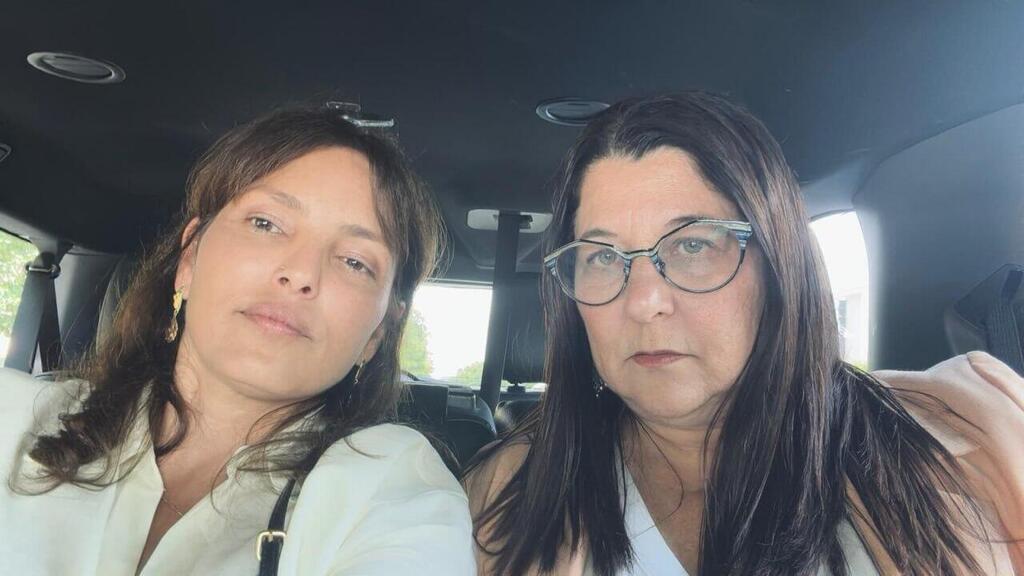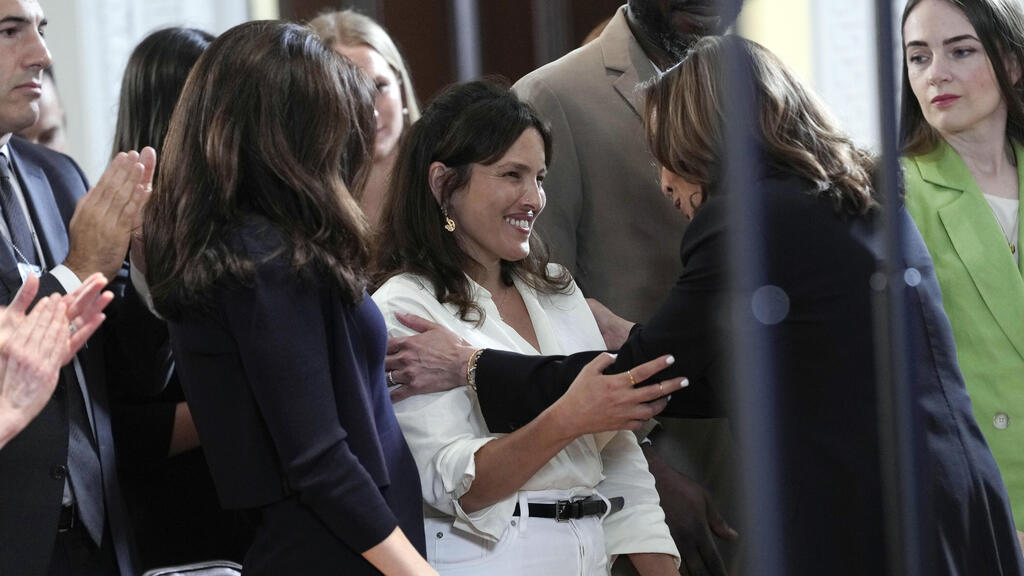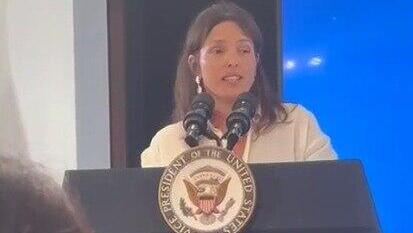Amit Soussana's journey since her release from Hamas captivity had been reported around the work. She bravely shared how she was sexually assaulted and mistreated by the terrorist who held her captive after her abduction to Gaza during the Hamas massacre on October 7.
Soussana decided to speak out although still in the early stages of recovery accompanied by Professor Siegal Sadetzki, who has been helping her piece her life back together.
Sadetzki is well-known in Israel after she had led its fight against the spread of coronavirus in the early months of the COVID-19 pandemic, during her tenure as Head of Public Health Services at the Health Ministry. Since the massacre and as one of Israel's top epidemiologists and public health experts she had taken it upon herself to support the Soussana family after Amit was taken from her home in Kfar Aza and has been going hand in hand with the freed hostage since she was released.
Soussana spoke openly about her ordeal in and interview with the New York Times, which focused global attention on the atrocities committed by Hamas terrorists and particularly on the sexual violence that they perpetrated. She described how her captive released her from the Iron chain she was bound by when he insisted she take a shower. Although she refused, he led her to the kitchen, showed her a pot of boiling water on the stove, and then took her to the bathroom, where he gave her the hot water to pour over herself.
When she tried to cover herself with a towel, the terrorist hit her. "Amit, Amit, take it off," he commanded, weapon in hand, forcing her to comply. "He sat me on the edge of the bathtub," she recounted. "I closed my legs and resisted. He kept hitting me, put his weapon in my face, and then dragged me to the bedroom." After sexually assaulting her, he went into the shower, leaving her naked.
Sadetzki had not spoken publicly until now. In an exclusive interview with ynet and its sister publication Yedioth Ahronoth, she describes their special bond and the repercussions of captivity on Soussana's well-being. "Amit will not be able to return to her life until all the hostages are back home," she says.
"In captivity, the terror is constant, the uncertainty overwhelming. Nothing is guaranteed. There's no certainty about daily food rations, whether they'll stay in one place or be moved, or how the captors will behave. In the tunnel, their water was rationed, and there was a fear it would run out. At one point, a gun was held to her head."
The connection between Sadetzki and the Soussana family began after the massacre. "I thought about how I could help," the doctor recallד. "Later, I was approached and asked if I wanted to volunteer in the administration to assist the families of the missing and kidnapped. Fortunately, I was assigned to Amit Soussana's family. When I arrived, Amit was still considered missing. I spent many hours with her mother, Mira, and sisters, Shira and Liat, who did everything they could to bring her home."
Amit Soussana at the hostage release rally in Washington
Daily terror
The connection between Sadetzki and the Soussana family began after the massacre. "I thought about how I could help," the doctor recalls. "Later, I was approached and asked if I wanted to volunteer in the administration to assist the families of the missing and kidnapped. Fortunately, I was assigned to Amit Soussana's family. When I arrived, Amit was still considered missing. I spent many hours with her mother, Mira, and sisters, Shira and Liat, who did everything they could to bring her home."
An early demonstration of Soussana's courage was captured in a video showing her struggling with her captors on the way to Gaza. But now, Sadetzki reveals the real motivation behind Amit's bravery. "She was certain she would be rescued before being taken to Gaza, so she tried to buy time and delay her entry as much as possible," she explained. "She was confident she would be saved, which is why she fought the terrorists."
A few days after her family watched the video, before it was clear it was Amit, the official announcement came that she had indeed been kidnapped to Gaza. "I stood there and realized the absurdity of this story," Sadetzki said. "The family was just told their beloved daughter is held by Hamas, and they were happy because she was alive. Understanding that this news, as terrible as it is, was a source of joy, made me realize how horrific this war is. A bad option is better than a worse one."
What did the returned hostages say?
"In captivity, the terror is daily, the uncertainty is overwhelming. Nothing is guaranteed. Certainty about the daily food ration, whether they will stay in the same place or be moved, and how the captors will behave each day. In the tunnel, they had a water ration, and one day there was a fear it would run out. At one point, a gun was held to her head."
Amit Soussana at the White House meeting with Kamala Harris Amit Soussana's emotional meeting this week with U.S. Vice President Kamala Harris (Photo: Susan Walsh, AP)
At the lowest point
Throughout the conversation, Sadetzki emphasizes Soussana's emotional intelligence. She quickly understood the situation and learned to navigate it. "One example of this is her brave decision to get herself and the other hostages she was with out of the tunnel," Sadetzki said. "Amit described being in the tunnel as one of the most difficult moments in captivity because there was no air. All she wanted was to get out and be in the apartment, despite the bombings above ground. Amit stubbornly negotiated with the captors to get them out of the tunnel, and she succeeded. They initially told her it was dangerous above, but Amit insisted, and the hostages indeed left the tunnel. We are talking about staying in a dark tunnel 40 meters deep. The decision was really to 'dig' into the captors on this matter. It's complex because you need to be persistent but not annoy them."
And all this time, she was very close to her home in Kfar Aza. "One of the hardest things for her was the feeling of being so close to home. The distance to Kfar Aza was minimal. She was chained for three weeks with an iron chain to her ankle. It was in an innocent-looking children's room with SpongeBob toys, and suddenly she looked in the mirror and saw herself in a state of helplessness. She said to herself, 'How low can one go?'"
Amit Soussana will not be able to return to her life until all the hostages are back home.
When did Amit decide to reveal what she went through? "Amit knew even during her captivity in Gaza, while the events were happening, that she would speak out. No one pressured her; it came from within. She knew it was essential to expose what had happened. Amit is not a victim but a person who fights to make it clear that such actions are unacceptable, even in war, and that violence against women, men, and all human beings must be condemned. After her testimony was published in the 'New York Times,' there were attempts to discredit her account. Hamas's response was ridiculous."
Sadetzki recounts that Soussana was moved from place to place and had different captors. Even the other hostages with her changed. "Even in the places where the worst things happened to her, when she was told she was being moved elsewhere, she felt fear because, despite the familiarity with the terrible conditions, she had learned the mechanisms that set the boundaries," she says. "On the day of her release, it happened very quickly. The terrorist guarding her said in broken English, 'you one hour Israel,' and that was it. There was no prior preparation, but it was accompanied by emotional abuse. The day before her release, the terrorist hung up the phone and suddenly told her, 'Amit, we wanted to release you today, but Israel can't find you on the lists. They don't want to release you.'"
Sadetzki adds: "Amit was mostly with male captors, but the person who led her to freedom was an older woman. She was taken to the street with one of the terrorists, and they waited outside until a very old and thin woman appeared. The terrorist told her to go with the woman, and they held hands and walked down the street to the building where Amit was taken to the command post and then to Palestine Square to the Red Cross."
Professor Siegal Sadetzki: "Amit cannot continue her life or return to her life until the other hostages return from Gaza. Mentally, she cannot move on until everyone comes back. Part of her soul remains in Gaza, and it will stay there until the last hostage returns."
Daughter, sister, friend
On November 30, after 55 days in captivity, Amit returned home in the final release phase. Since then, Sadetzki has been closely accompanying her. "Sometimes I feel like she is my daughter, sometimes my sister, and sometimes my best friend," she says. "The support touches almost every aspect of life, such as organizing an apartment and closely supporting her activities, including how to tell her story. Amit returned with nothing. She wore a tracksuit that Hamas bought her for the day of her release, and that was it. Everything had to be rebuilt from scratch."
How do you start returning to life from such hell? "I want it to be clear: Amit cannot continue her life or return to her life before the other hostages return from Gaza. Mentally, she cannot move on until everyone comes back. Part of her soul remains in Gaza, and it will stay there until the last hostage returns. From my time with Amit, I understand how every minute in Gaza is a threat to the soul, life, and body. There is no possibility of continuing with life without closure. She wants peace and quiet but cannot move on and start true recovery until the last hostage returns to Israel. It's as simple as that."







